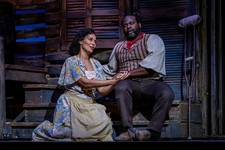The North Carolina Symphony’s Great Artists Series can chalk up another triumph with the recital by renowned violinist Cho-Liang Lin at the A.J. Fletcher Opera Theater on April 6. Accompanied by André-Michel Schub, winner of the 1981 Van Cliburn International Piano Competition, this was a wonderfully balanced program-traditional yet spanning many styles and moods.
Although not billed as such, Lin’s concert can be viewed as a fitting tribute to Dorothy DeLay, longtime professor of violin at the Juilliard School, who passed away on March 24. Lin, who is also now on the Juilliard faculty, first studied with Itzhak Perlman but continued his studies with DeLay and became yet another extraordinary talent to emerge from her studio.
The evening began with a rarely-heard arrangement of Stravinsky’s Suite Italienne , for violin and piano. This work started out as the ballet Pulcinella , after themes by the very short-lived baroque composer Giovanni Pergolesi (who died when he was 26); it was immediately hailed as a triumph of Stravinsky’s neoclassic period. An arrangement for cello and piano followed and also became quite popular. The version for violin, prepared with the help of (or perhaps by) Samuel Dushkin, follows almost exactly the cello version and is one of those pieces that is almost impossible to dislike. Vibrant rhythms, beautiful melodies, and enough “modern” harmonies make this a great opener. Lin was superb, especially in his rhythmic drive, which is so important in Stravinsky. It also became apparent right away how much fun he has playing. He immediately drew the listeners in to share in his joy.
Beethoven’s Violin Sonata No. 7, in C Minor, was presented next. This work, while not as well known as, say, the “Kreutzer” and “Spring” sonatas, is as representative of Beethoven’s style as you can get. In the abrupt dynamic changes in the opening Allegro, the slow, beautifully developed melodies of the Adagio, the quick, syncopated Scherzo and the virtuosic Finale, Lin demonstrated extraordinary bow control and attention to all details of the score, without sounding planned and studied. It should be noted that the so-called violin sonatas were conceived not strictly as showcases for the violinist but as sonatas for piano and violin. Schub was flawless in his playing and sensitive to the give and take required when, despite the equality of the parts, it is inevitable that the violinist is seen as the “soloist.”
The second half treated the audience to two of the greatest works in the repertoire. The Sonata in G Minor by Debussy is a work that is the epitome of “color” in music. You usually don’t think of the word “orchestration” applying to one instrument, but the only way to describe this work is a palette of colors for violin. Unlike the Beethoven before and the Brahms that was yet to come, the piano serves mainly to underscore the lush harmonies and play off the incredible effects of the violin. Lin elicited the almost otherworldly beauty of Debussy’s score with his lovely round tone and great dynamic contrast. If you want to experience impressionism in music, you can’t do better than this. Lin took us on a wonderful journey and gently placed us down.
Our return brought us back in time about 50 years to a very different style. Brahms’s Violin Sonata No. 3, in D Minor, is not only one of the masterpieces for violin but also a shining example of romanticism in music. Technically demanding at the highest level for both parts and requiring great expressive and interpretive skills, this was Brahms’s final violin sonata of the three that he wrote. At times dense and chromatic, while in other movements almost folk-like, this was a tour de force that brought the audience to its feet at the conclusion.
Lin exemplifies what a concert artist should be. He is expressive without being so overly demonstrative that he detracts from the music. His movement and facial expressions convey a great love and understanding of the slightest nuances and subtleties of the score. At times it seems that he is choreographed to his playing but his performances unfold in a very natural and unaffected manner. Lin and Schub communicate in an effortless and unobtrusive style that can only come when two artists have played together for years and know not only their individual parts but also the totality of the works they perform.
Lin broke his silence as the audience refused to let the evening end without an encore. He announced his first selection, Ravel’s “Piece en forme de Habañera” an arrangement of a solo piano work. The piano played with the insistent tango rhythm while the violin traveled through an ethereal landscape. One could hear the “ooooh” from the audience as Lin told the audience that he would close out the concert with a perennial encore favorite-Kreisler’s “Liebesfreud” (“Love’s Joy”). This was indeed a fitting ending to a wonderful evening-joyous, virtuosic playing from artists that those present will not forget for a long time.











